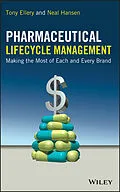A comprehensive guide to optimizing the lifecycle management of pharmaceutical brands The mounting challenges posed by cost containment policies and the prevalence of generic alternatives make optimizing the lifecycle management (LCM) of brand drugs essential for pharmaceutical companies looking to maximize the value of their products. Demonstrating how different measures can be combined to create winning strategies, Pharmaceutical Lifecycle Management: Making the Most of Each and Every Brand explores this increasingly important field to help readers understand what they can and must do to get the most out of their brands. Offering a truly immersive introduction to LCM options for pharmaceuticals, the book incorporates numerous real-life case studies that demonstrate successful and failed lifecycle management initiatives, explaining the key takeaway of each example. Filled with practical information on the process of actually writing and presenting an LCM plan, as well as how to link corporate, portfolio, and individual brand strategies, the book also offers a look ahead to predict which LCM strategies will continue to be effective in the future. While the development of new drugs designed to address unmet patient needs remains the single most important goal of any pharmaceutical company, effective LCM is invaluable for getting the greatest possible value from existing brands. Pharmaceutical Lifecycle Management walks you through the process step by step, making it indispensable reading for pharmaceutical executives and managers, as well as anyone working in the fields of drug research, development, and regulation.
Autorentext
TONY ELLERY is a consultant with Ellery Pharma Consulting. Until September 2008, he was the Head of Pharmaceutical Lifecycle Management in Portfolio Management at Novartis AG. Prior to this, he occupied positions of increasing seniority in research, development, and marketing at different companies, including Roche, Ciba Vision, and Novartis. Dr. Ellery has served as a member of the Ciba-Geigy Research Advisory Board and the Novartis Pharma Development Management Board. He is a popular speaker on lifecycle, project, and portfolio management.
NEAL HANSEN is the Managing Director of Healthcare Consulting within the Informa Group, encompassing Datamonitor Healthcare Consulting and Phasic Strategy. Previously, he was the European Head of Consulting within Wood Mackenzie's Life Sciences Practice. He works with many key players in the pharmaceutical industry to support effective decision making for brand and portfolio strategy and has chaired and spoken at numerous conferences in the field of lifecycle management and the changing nature of the generic drug industry.
Inhalt
Acknowledgments xvii
Introduction xix
Part A Lifecycle Management Business Environment 1
1. Challenges Facing the Branded Drug Industry 3
1.1 Depleted NME Pipelines/Lower R&D Efficiency 4
1.2 Higher Development Costs 8
1.3 Safety Concerns 9
1.4 Tougher Environment for Pricing, Reimbursement, and Listing 12
1.5 Increased Competition 16
1.6 Earlier Genericization 17
1.7 Faster Sales Erosion Following Patent Expiry 18
1.8 Poor Image of Branded Drug Industry 20
1.8.1 Prosperity of the Branded Drug Industry 21
1.8.2 Lack of Innovation 22
1.8.3 Marketing Spend and Tactics 22
1.8.4 Safety Issues 23
1.8.5 Keeping Generics Off the Market 24
1.9 Diversification 26
2. The Life Cycle of Industries, Technologies, and Brands 30
2.1 Diffusion of Innovations 30
2.2 The Lifecycle Curve 32
2.3 Lifecycle Phases 34
2.3.1 Development Phase 34
2.3.2 Introduction Phase 35
2.3.3 Growth Phase 35
2.3.4 Maturity Phase 36
2.3.5 Decline Phase 36
3. The Life Cycle of a Pharmaceutical Brand 38
3.1 Lifecycle Curve of Pharmaceuticals 41
3.1.1 Slow Rate of Growth during the Growth Phase 42
3.1.2 Lack of a True Maturity Phase 43
3.1.3 Precipitous Decline Phase 43
3.2 Factors Affecting Rate of Conversion to Generics 44
3.2.1 Government Policy 44
3.2.2 Disease 44
3.2.3 Size of Brand 45
3.2.4 Hospital versus Nonhospital Drug Usage 45
3.2.5 Active Substance and Other Barriers to Entry 46
3.3 The Life Cycle of a Pharmaceutical Brand 46
Part B Lifecycle Management Regulatory and Legal Environment 55
4. The Generic Approval Process 57
4.1 United States 57
4.2 Europe 59
4.3 Japan 61
5. HatchWaxman Legislation and Its Effects on LCM 62
5.1 HatchWaxman Act of 1984 62
5.2 Medicare Modernization Act of 2003 64
5.3 FDA Amendments Act of 2007 65
5.4 Q1 Program Supplemental Funding Act of 2008 66
5.5 Discussion of Hatch-Waxman Legislation 66
6. U.S. Health-Care Reform 2010 69
7. European Sector Inquiry 72
Part C Patents and Exclusivities 77
8. Patents and Other Intellectual Property Rights 79
8.1 Nonpatent Intellectual Property Rights 79
8.2 What Are Patents? 81
8.3 What Is Patentable? 83
8.3.1 Patentable Subject Matter 83
8.3.2 Novelty 84
8.3.3 Inventive Step 85
8.3.4 Utility 86
8.3.5 Disclosure 86
8.4 How Long Does a Patent Last? 87
8.5 Patent Term Restoration in the United States 87
8.6 Supplementary Protection Certificates in Europe 88
8.7 Patent Term Extension in Japan 89
8.8 How Are Patents Obtained? 89
8.9 Patent Enforcement 91
8.10 Types of Patents 92
8.10.1 Composition of Matter Patent 93
8.10.2 Medical Use Patent 93
8.10.3 Formulation Patent 94
8.11 KSR versus TeleflexRaising the Nonobviousness Bar 94
8.12 Patent Strategy 96
9. Nonpatent Exclusivities 99
9.1 NCE Exclusivity (United States) 99
9.2 New Clinical Study Exclusivity (United States) 100
9.3 Data and Marketing Exclusivity (Europe) 100
9.4 Data Exclusivity (Japan) 101
9.5 Orphan Drug Exclusivity 101
9.6 Pediatric Exclusivity 103
9.7 180-Day Generic Product Exclusivity 105
10. Patent Settlements 107
Part D Developmental LCM 113
11. Strategic Principles of Developmental LCM 115
11.1 Developmental LCM Goal 1: ...
